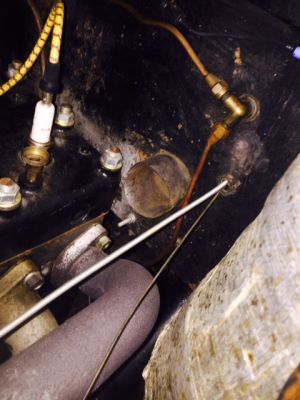- Home
- About Us
- Join/Renew
- Member Benefits
- Member Pages
- Log In
- Help
- Museum Store
Seems it’s just a 1/4 turn brass drain cock which was and is still a standard hardware item; a quick search of my Grainger and McMaster-Carr catalogs reveal several candidates which could serve well once a slight modification to the handle is made and the extension handle pinned on.
I think I will stick with my drain plug but I did think about replacing it.
There is one that appears to be almost exactly like the one in the above photo, except without the “Pierce” label, at this site:https://www.rubylane.com/item/460150-2576/1930s-Curly-Silk-Wool-Auto-Lap
It’s sure expensive, but at least it’s a couple of photos you might be able to use.
If they aren’t available, figure out how to make them and offer them for sale here.
Agree completely with Greg here: Our Cars once lived in the Real World, and that’s the way it is.
I’m just glad my Car wasn’t made into a tow truck or farm truck (or an Army tank, for that matter…) sometime in the past 90 years!
Hi, Charles, thanks for sharing your interesting truck, and welcome!
Steering wheel resembles a Lincoln Zephyr-Continental.
Thanks, Peter! I will need to reexamine the aft torque arm joint on my Car.
Someone already mentioned that earlier; I don’t know how I missed it. I scare myself sometimes…
Thanks!
Roger, Stuart: How many times were the words “She’ll kill me”” muttered while we walked around it?”
The fellows are right: Glyptal is for the inside. I did not mean to be so imprecise.
The aluminum crankcase on my Series 80 is plain not finished in any way far as I can tell and it looks fine to me, especially for a driver.
Looks like the Car we saw during the Gilmore weekend: a real beauty! Congratulations!
Glyptal is one product, commonly called crankcase paint, but really a casting sealer. Aluminum castings are commonly porous and will seep. I have seen castings smoothed with body fillers for that smoooth look. Seems to me that an exterior finish similar to the original is sufficient but for show cars a better finish is easier to clean and will withstand more cleaning. One shop I visited painted all engines with Imron 2-part: silver for the aluminum crankcases and gloss black or other appropriate color for the remainder. They did look really good. Maybe a clear sealer on the aluminum castings is what they were recommending, but the ones I saw which had the castings painted silver looked like new aluminum.
It seems to consist of a sheet-steel box which partially encloses the exhaust and intake manifolds, with an opening just behind the engine fan and an opening in the firewall to allow the engine fan to move air past the exhaust manifold and into the passenger area. The pull knob may be the reason there is an unused hole drilled on my Car’s dash.
Francisco also claimed an advantage to heating the intake manifold in cold weather which is probably somewhat valid in that era, given that there were often connections between the manifolds which the OEM intended for positive effects in cold weather.
There are a couple of ads for Francisco heaters being offered on Ebay. They show some different models: the manifold box we are discussing, plus a hot-coolant underdash model and one which has the exhaust manifold built in.
Worth looking at for those interested.
Hi, Peter, I don’t really need heat in the Pierce, but I am interested in learning useless info like this!
Jim: do you have a photo of one handy? Would you sell one?
That’s great information: I can’t wait to look around.
Thanks for sharing!
Thanks, George, I would really enjoy coming up with one of those! Maybe we will be able to find a photo or even one intact somewhere. One of my favorite tasks is learning about and looking for esoterica. Pretty useless, maybe, but as a member of the Keepers Of Odd Knowledge Society, well…
Engine side

Never saw rods chipped like that; have seen many old thick-Babbitt bearings like those. Thick Babbitt has lower strength and there can be problems with the initial bond as well as it starting to disbond and break up late in life. Sometimes pieces of main Babbitt find their way into the crank oil passages and into the rod bearings and rod passage to the wrist pin; sometimes the oil pan, sometimes smeared on the rest of the bearing, just as Greg said.
I have seen bearings with these defects run a long time undetected and I have even seen the time when the men would be forced to get one which had previously been discarded, blend out the edges of the failure, and run it, because they had no choice.
These are large engines not car engines, of course, but similar principles etc. as they were designed and built in the same era.
Congratulations! Many happy returns!
